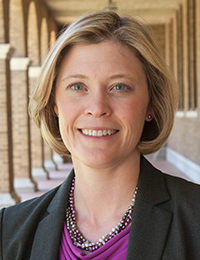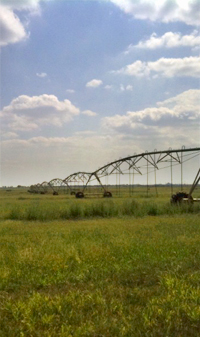Dr. Audra Morse Examines the Fate of Pharmaceuticals and Personal Care Products in Municipal Wastewater Systems
Edited by Javad Hashemi and Jeff Sammons

Dr. Audra N. Morse, an associate professor of civil, environmental, and construction engineering, is studying the effects of land application of wastewater effluent and agricultural runoff. Specifically, she and her colleagues are seeking to learn the effects or fate of pharmaceuticals and personal care products (PPCPs) when they pass through municipal wastewater systems and are applied to land application sites (LAS).
Morse's interest in the fate of PPCPs was initiated through a NASA grant that she received to examine amoxicillin and the potential impact of the reclamation of amoxicillin-tainted wastewater in space travel. Over time, this research has expanded to include a variety of PPCPs. Research funding has come from a variety of sources, including the EPA and municipalities.
Recently, Morse has been examining the potential ecotoxicity and fate of amoxicillin, triclosan, estrogen, ibuprofen, caffeine, ciprofloxacin, and many other common products and compounds that are a part of our daily lives. These PPCPs are often introduced into the wastewater supply through residential sources.
Through a recent grant from the City of Lubbock, the EPA, and Alan Plummer, Morse is sampling wastewater in Lubbock. Testing at the headworks, the waste-activated sludge (aeration basin), the chlorine contact chambers, the sludge train, and the effluent application site, she is attempting to understand the natural sorption, degradation, and impact that traditional wastewater treatment plants have on PPCPs. They have discovered that these compounds often travel through wastewater treatment plants unchanged or minimally changed, being discharged into rivers, lakes, or LAS.
While these PPCPs often enter the environment in very small quantities, the continuous release of these compounds and chemicals, particularly at LAS, can contribute to significant deposits that may have lasting effects on plants, animals, and humans through interactions with groundwater.

Studies have shown a negative impact on fish when exposed to wastewater effluent laced with PPCPs. However, it is not yet known if humans can be affected adversely, and how much impact is too much.
Additionally, it is not known how these PPCPs may behave over time and how they can potentially interact with one another. Federal, state, and local governments regulate the release of many common elements and compounds, but the sheer number of PPCPs and the lack of knowledge about the relative toxicity or ecotoxicity of these compounds has been prohibitive in determining standards or regulations.
Morse, her colleagues — specifically Todd Anderson — and her students are attempting to understand the level of sorption, bioremediation, and degradation that occurs at LAS for common PPCPs. They are attempting to understand if plants and soils are playing a role in bioremediation, or if these compounds are persistent, plaguing the environment for generations to come.
For many municipalities, the goal for wastewater is treatment, passage through the environment, and eventual usage as a drinking water source. However, if PPCPs are present in this drinking water source, potential exists for their passage into the filtered drinking water supply.
Morse is discovering that determining a standard degradation time scale for many PPCPs may be difficult. She and her team have identified half-lives and time scales for many compounds by themselves and in a variety of soils, including saturated and non-saturated soils. However, they have discovered interferences between multiple compounds. As an example, when combined, estrogen and triclosan have a slower degradation time scale compared to the degradation of each compound independently. Now, Morse is examining why the removal efficiency decreases when they interfere with each other.

Understanding the interactions between compounds is critical, as wastewater may contain dozens of unique compounds at any one time that interact with one another in various ways. Additionally, as the weather changes, the efficiency of degradation and water treatment varies. The introduction of many PPCPs can vary with the time of year to match cold and flu season, or other factors.
Overall, minimizing the impact on the environment and maximizing our water resources is the goal. If we can safely process larger quantities of our wastewater and deposit that clean water to our rivers and lakes, our farm fields, or even our drinking water, we can reduce our dependence on existing fresh water supplies and ensure safe environments for plants and wildlife.
Morse joined the Department of Civil, Environmental, and Construction Engineering in the Whitacre College of Engineering as an assistant professor in 2003. She received a Bachelor of Science and a Master of Environmental Engineering as well as a Doctor of Philosophy in Civil Engineering from Texas Tech University. She recently received the Texas Tech President's Excellence in Teaching Award for 2010 and the 2010 Chi Epsilon James M. Robbins Excellence in Teaching Award for the Southwest District.
Morse has received more than $1.3 million in research awards from NASA, the U.S. Department of Energy, the U.S. Environmental Protection Agency, the Texas Department of Transportation, and other organizations.
Edward E. Whitacre Jr. College of Engineering
-
Address
100 Engineering Center Box 43103 Lubbock, Texas 79409-3103 -
Phone
806.742.3451 -
Email
webmaster.coe@ttu.edu
